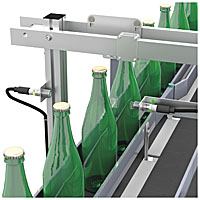Operation Principle

Ultrasonic sensors are used for bottle detection.
Ultrasonic sensors are capable of both contact-free object detection and measuring the distance of objects from the sensor. To measure, they send high-frequency sound pulses. The pulses spread out in a cone shape into the air and are reflected as soon as they hit a surface. The sensors operate according to the principle of time-of-flight technology. This allows objects to be detected and their distance from the sensor to be measured.
Physical basics
Sound waves at frequencies above around 16 kHz that are inaudible and non-harmful to humans are called ultrasonic. They can be spread via different materials: solid objects (material control), human or animal tissue (medical sonography tests), liquids (echo sounding in ships), or the surrounding air. Depending on the sensor type, this is possible at a distance of only a few inches and all the way up to several feet. The diffusion of sound waves in a vacuum, however, is not possible. Because the transmission behavior and the acoustic velocity vary in different materials, sensors have to be specially adapted to the respective medium.
Piezoelectric Transducer
In order to produce ultrasonic waves, a piezoelectric transducer, the so-called piezo ceramic, is required. Once they come upon an object, they are reflected (echo) and transformed into an electric signal again by the piezo ceramic. The sensor measures the time lag between the transmitted ultrasonic pulse and the received echo and determines the distance to the object via acoustic velocity. Therefore, the procedure is also called echo transit time method. Ultrasonic transducers work with different frequencies, ranging from 40 … 850 kHz.







 +47 3557 3800
+47 3557 3800